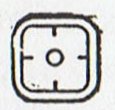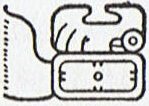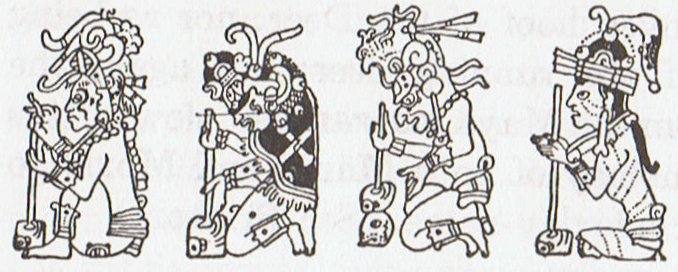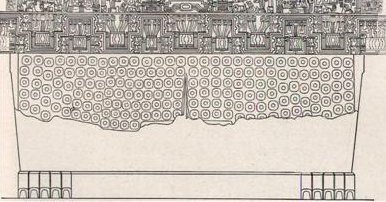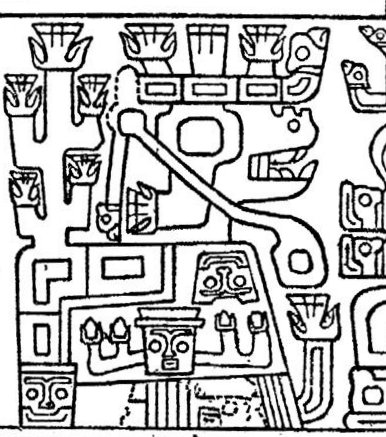5. If number 349 should be understood as a reference to the mouth of the fish down there, then we must consider how my idea about Te Pe'i (presumably the same fish) could be located in line b1. First I will try to motivate my idea without using complicated number games, only by looking at the signs. I have suggested the southern fish is like Blood Moon, like the receiving end of the flow from The Great One. A receptacle is basically a type of mouth, and we should remember the Chikin sign (cfr at A Common Sign Vocabulary): ... For the East we have the glyph Ahau-Kin, the Lord Sun, the Lord of Day; for the West we have Manik-Kin, exactly corresponding to the term Chikin, the biting or eating of the Sun, seizing it in the mouth ...
If side b of the G tablet is its back side, then it ought to begin with the direction west, where Sun is taken care of in the evening. Mother Earth is swallowing him to enable his rebirth next morning.
The generation of a new fire ('one more' as in 1-1) is based on the 'embers' (hetu) of the Old Fire, presumably represented by Jupiter (Father Light) in Ga8-16 and Gb1-2. Gb1-3 (a day of Venus) could be a point from where to count, from where a new 'year' is born, similar to Rogo in Gb6-26 (a day of Sun). But Rogo in Gb1-3 has a 'hole' (mata) in her stomach, perhaps representing 'the fruit' from the 'tree' of Jupiter. ... What? Well! What's the fruit of this tree? Shouldn't this tree bear something sweet? They shouldn't die, they shouldn't be wasted. Should I pick one? said the maiden ... I say 'her' because this Rogo mata could reflect α Andromeda (Sirrah) by being located in the 'antipodal' part of the year. A hole suggests 'water', as for instance in the 177 signs in the skirt (all around her) of Pachamama:
Below her midline water finds its place, while flames of fire are drawn higher up and move upwards:
In A Common Sign Vocabulary I wrote: ... The statue of Pachamama exhibits a variant of pu where the upper hole seems to be closed. The spring path of Sun begins at the temple (or at the ear hole) of the central beast - looking like a hippopotamus - and it then leads obliquely downwards ending in a great 'hole'. Maybe the path of Sun is beginning with a 'closed fist' - all 'fingers' are still intact and nothing has as yet been counted. At the other end there is a 'zero', nothing is left and all has been counted. Fish heads are visbile close to the bottom hole, but otherwise there are predominatly signs of fire. At front in the headgear is an eagle's head with a single-rimmed eye. Another such is hanging down at the back of her head. I guess the 'hippopotamus' is a female. At any rate she has her mouth open as a creature of spring should ... We can now add that the face to the left of the open hole ('zero') is upside down. Furthermore, a 'hole' on the front side should be mata, I think, in contrast to pu which has a female ring:
10 days beyond Gb1-3 (after an inserted central sequence of 9 glyphs) we can see Spring Sun tumbling down and then a pair of poporo signs are following:
If we could say that poporo in Ga3-11 indicates that Old Sun has been buried and is now generating a new 'fire', then the pair of poporo in Gb1-14 and Gb1-19 ought to indicate a similar situation, where a Moon type of light is sprouting - she has 2 'faces' and there must therefore be 2 small plants.
From poporo in Ga3-11 (Saturn) up to and including poporo in Gb1-19 (Sun) there are 177 days:
Possibly we should count 3 * 11 = 33 (one more than 32) on side a, in contrast to 11 * 9 = 99 on side b. Sun has only 1 face, but Moon has 2. Tagata, a fully grown person, is growing from the head (inherited from the old generation): ... Ku descended into the ground right where he had stood until only the top of his head was visible. His family waited around the spot he had last been, day and night watering it with their tears until suddenly a small green shoot appeared where Ku had stood ... At the top end of the vertical line with 'the head of Ku' at bottom (in Ga3-11) there is another type of sign than those in the correponding positions of poporo in Gb1-14 and Gb1-19. These presumably depict the 'canoe' of Moon, which close to the horizon in tropical waters always is floating right side up and horizontally in contrast to the waxing and waning shapes we are accustomed to. There are 2 such 'Moon canoes' for each poporo and 2 months are necessary to fill a 59 night long double-month. The more rounded shape of the top sign in Ga3-11 will then be a sign for Sun. At left is his white side and at right is his dark side. That is, the front side lies in front. In Ga3-10 tagata ragi is drawn without light - it is a tagata vero sign and the season without light is here ending (fully grown). Hau tea has Janus eyes. We have seen that 472 = 70 + 402 (which equation then lead us to Ga3-10):
Considering that Ana-mua might be represented by glyph number 186 on the front side, an alternative way to count is to say that the position of Antares is 186 - 70 = 116 = 4 * 59. Today Antares arrives 70 days after spring equinox south of the equator. Therefore it could also be alluded to at Gb4-28, to suggest a similar star of birth (*). But the length of the cycle born here cannot be a normal Sun cycle (summer), it is too long. And the glyph play takes place on side b. |
|||||||||||||||||||||||||||||||||||||||||||||||||||||||||||||||||||||||||||||||||||||||||||||||||||||||||||
